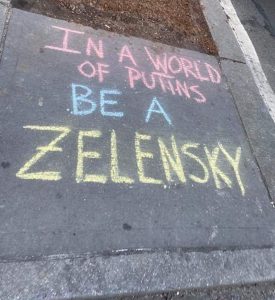Leadership in the Ukraine War
There have been two very different leadership styles in the invasion of Ukraine by Russia in February 2022. We have seen the impact of poor leadership and the benefit of strong leadership in the conflict, and there are many parallels that can be taken for business. Leadership in the Ukraine War has brought to the world’s attention on the impact that leadership can have.
Firstly, the world is aware that Volodymyr Zelenskyy had leadership thrust upon him, being elected to be President in what some considered to be a “joke” campaign by a comedian. However, the invasion of his country has allowed him to show that he has leadership skills that are exactly what his country needed at the time. He has not escaped the country in a private jet filled with foreign cash and treasures, and instead, put on military fatigues and inserted himself in amongst his people. The people of Ukraine have a shared and known goal – repel the invaders at all costs. We also see regular people getting involved in the war effort – without needing to be instructed or directed, they are responding to requests from the military for camouflage nets and building hedgehogs where they have to work out how to build them – without specific direction.

If you compare that to the Russian efforts – conscripts and military were sent to the front line with little to no direction, many stated that they did not know their aims or that they were lied to about “military exercises”. High-value hardware such as tanks and encrypted communications has been abandoned by Russian troops – with no consideration of the intelligence value of the hardware or the ability for Ukraine to re-use the hardware against them. Leaders have been going to the front lines, and end up killed as they are detected – with Russia losing 5 senior leaders so far. We see stories of Russians having antiquated and old equipment, not using their latest weapons, and poorly supplied.
The leadership style of the Russian military is that the low-level troops are not empowered to make decisions, and furthermore, they are not provided strategic aims or even tactical goals. The Russian troops will abandon a vehicle that has run out of fuel, as they don’t have the logistics or empowerment to make a decision. The leaders are a bottleneck, they cannot respond to every issue or concern, and their troops have a hesitancy and even fear of asking for direction to operational matters from a general – further compounding the issue.
Compare this with most Western militaries, where troops at any level of leadership – right down to squad leaders – are trained in how to lead and make decisions under pressure, given autonomy and standard procedures for common events and regular tactics and operational issues. When the military from different Western countries do military exercises together, there are shared operational protocols and ways of working – improving operational efficiencies.
The parallels for business
Leadership used to be autocratic – a few elites who would inform the factory workers that they needed to improve their production figures, that workers would need to continue to use the old equipment. The expectation was that workers should be happy to get their hours and just do their job – “head down, bum up“, and do what they are told. The Russian approach is no longer valid for business.
Modern business should be more empowering for the team – provide them with the right tools, an understanding of the overall direction and strategy, standard processes and approaches for how to respond in a consistent way, frameworks that guide new decisions, and most importantly and shared culture that ensures motivation is in the right direction.